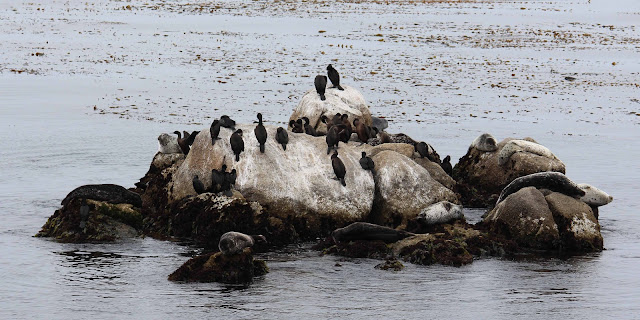 |
| The Pinnacles are striking |
 |
| Map: Framable Wanderings |
Elevation within the boundaries range from 824 to 3,304 feet at the peak of North Chalone Peak.
The Park is geologically significant because the massive stone pinnacles ...
 |
| One of these things is not like the other |
... do not match the surrounding rolling hills ...
 |
| Hills |
That's because the eroded leftovers of the western half of an extinct volcano moved 200 miles from their original location on the San Andreas Fault, embedded in a portion of the California Pacific Coast Ranges.
 |
| It certainly looks volcanic |
Large-scale earth movement also created talus caves that can be found in the park. Deep, narrow gorges and shear fractures were transformed into caves by large chunks of rock falling from above and wedging into the cracks, leaving an open area below. Caty and I didn't visit any caves.
 |
| Passport stamp |
There is no road through the park. From the pictures and video, it, like everything else in California, is much prettier in the spring than summer. It's very yellow now and all the creeks are dry.
In the 1880s the area was known as the Palisades, but it shifted to Pinnacles around 1891.
 |
| The Park's namesake |
Schuyler Hain, a local homesteader led tours in the area, advocating the preservation of the Pinnacles. In 1906, Pinnacles Forest Reserve was established. It became Pinnacles National Monument in 1908 and then a National Park this January.
The Park has some of the highest densities of Prairie Falcons anywhere in North America. Peregrine Falcons breed there and a California Condor re-establishment program has been in place since 2003.
We saw only Steller's Jays ...
 |
| Pretty blue against the green trees |
California Thrashers ...
 |
| This was a new bird for me |
... and a Greater Roadrunner ...
 |
| Meep Meep! |
Although there is significant wildlife, we saw only a Ground Squirrel ...
 |
| It was a hot, hot day |
Thirteen species of Bats have been documented at Pinnacles, with a further three species considered likely. The talus caves provide roosting and breeding habitat for the Bats.
 |
| Pretty but rugged |
Vegetation in the Park is about 80 percent chaparral with woodlands, riparian and grasslands merged into the chaparral.
In the warmer portions of the park, large areas of greasewood cover slopes, along with manzanita, gray pine, canyon live oak and blue oak.
Cooler portions of the park have higher proportions of pines and oaks, together with California buckeye, hollyleaf cherry, and coffeeberry. Willows and elderberries are found along the intermittent streams.
Fire has been a dominant influence on the region's flora, both from natural causes and from intentional intervention by people. When the region was inhabited by Native Americans, they used fire as a tool to encourage the growth of preferred food sources, and to herd small game during hunting. Since the disappearance of native peoples, the hills have become brushier.
Trip date: July 26-August 8, 2013






































